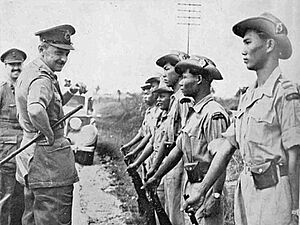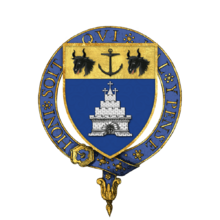Gerald Templer facts for kids
Quick facts for kids
Sir Gerald Templer
|
|
|---|---|

General Sir Gerald Templer in Malaya, 1953
|
|
| Nickname(s) | "Tiger of Malaya" |
| Born | 11 September 1898 Colchester, Essex, England |
| Died | 25 October 1979 (aged 81) Chelsea, London, England |
| Buried |
St. Michael's churchyard, Wilsford, Salisbury, Wiltshire, England
|
| Allegiance | United Kingdom |
| Service/ |
British Army |
| Years of service | 1916–1958 |
| Rank | Field Marshal |
| Service number | 15307 |
| Unit | Royal Irish Fusiliers Loyal Regiment (North Lancashire) |
| Commands held | Chief of the Imperial General Staff (1955–58) Eastern Command (1950–52) 6th Armoured Division (1944) 56th (London) Infantry Division (1943–44) 1st Infantry Division (1943) XI Corps (1943) II Corps (1942–43) 47th (London) Infantry Division (1942) 210th Independent Infantry Brigade (Home) (1940–41) 9th Battalion, Royal Sussex Regiment (1940) |
| Battles/wars | |
| Awards | Knight Companion of the Order of the Garter Knight Grand Cross of the Order of the Bath Knight Grand Cross of the Order of St Michael and St George Knight Commander of the Order of the British Empire Companion of the Distinguished Service Order Mentioned in Despatches (2) Commander of the Legion of Merit (United States) Commander of the Order of Leopold II (Belgium) Croix de guerre (Belgium) Grand Officer of the Order of Orange-Nassau (Netherlands) Grand Commander of the Order of the Defender of the Realm (Malaya) |
Field Marshal Sir Gerald Walter Robert Templer (1898–1979) was a very important officer in the British Army. He fought in both World War I and World War II. He also helped deal with the Arab Resistance in Palestine.
From 1955 to 1958, Templer was the top military adviser to the British Prime Minister during the Suez Crisis. He is also known for helping to create the National Army Museum in the United Kingdom.
Templer is most famous for his role in the Malayan Emergency. He led the fight against the Malayan National Liberation Army (MNLA). Some people say his methods were a great example of a "hearts and minds" campaign. This means winning over the local people. However, others disagree, saying he used strict controls and forced people to obey.
He used some tough strategies during this time. These included moving people into special "New Villages" and forcing some ethnic groups to relocate. He also approved of collective punishment for civilians and used special Iban-headhunters. Some of his methods, like using Agent Orange to destroy crops, were later tried by the United States in Vietnam.
Contents
Early Life and Education
Gerald Walter Robert Templer was born on September 11, 1898, in Colchester, Essex, England. He was the only child of Lieutenant-Colonel Walter Francis Templer. His father was in the Royal Irish Fusiliers.
Gerald went to school in Scotland and then to a boarding school. In 1912, he started at Wellington College, Berkshire. He didn't enjoy his time there much at first. He later said he "loathed and detested" it, but he did make many friends.
Serving in World War I
In December 1915, Templer joined the Royal Military College, Sandhurst. This was a military training school. He finished a short course because of the war. On August 16, 1916, he became a second lieutenant in his father's regiment. He was not yet 18 years old.
Because he was so young, he couldn't go overseas right away. He stayed in Ireland with a reserve battalion. In October 1917, when he was 19, he finally went to the Western Front. This was where much of the fighting happened.
His battalion, the 1st Irish Fusiliers, fought in the Battle of Cambrai. Templer himself was not directly involved in this battle. In February 1918, he was promoted to lieutenant. Soon after, he became very ill with diphtheria and was sent back to England.
He returned to his battalion later that year. He fought in the Hundred Days Offensive. This was a series of battles that helped the Allies win the war. The war ended on November 11, 1918. Templer was lucky not to be wounded. However, the war deeply affected him. He later spoke about the terrible sights he witnessed.
Between the World Wars
Templer stayed in the army after World War I. He served in Persia (now Iran) and Iraq in 1919–20. This was part of an effort to stop the spread of communism. After that, he served in Egypt.
He returned to England and attended the Staff College, Camberley from 1928 to 1929. He was the youngest student there at 29. He later transferred to the Loyal Regiment (North Lancashire) to get a promotion to captain.
In 1931, he became a staff officer with the 3rd Division. He then worked at Northern Command in York in 1933. In 1935, he became a company commander in the 2nd Loyals. While at Northern Command, he met Harold Alexander. They became good friends.
In January 1936, Templer went to Palestine. He commanded 'A' Company during the Arab revolt. For his actions, he received the Distinguished Service Order (DSO). This experience deeply affected him. He said he felt strongly about "racial and religious clashes."
In 1937, he returned to England. He became a staff officer for the 53rd (Welsh) Infantry Division. In 1938, he was promoted to major. He worked at the War Office in Military Intelligence. Here, he helped create and train the Intelligence Corps.
Serving in World War II
When Second World War began in September 1939, Templer was an acting lieutenant-colonel. He was chosen to be a senior staff officer for the British Expeditionary Force (BEF) in France. His job was mainly about counter-intelligence and security.
In May 1940, the German Army attacked France. Templer helped form "Macforce" to defend a river. This force gathered various scattered units. After some small fights, it was disbanded. Templer was evacuated back to England from Dunkirk.

Back in England, Templer was ordered to raise the 9th Battalion of the Royal Sussex Regiment. This was a new battalion formed after the Dunkirk evacuation. He worked hard to train his new recruits, even with limited equipment.
In November 1940, he took command of the 210th Independent Infantry Brigade (Home). This brigade was responsible for defending the coast of Dorset from a possible German invasion. His commander, Lieutenant-General Bernard Montgomery, thought highly of Templer.
In April 1942, Templer became the General Officer Commanding (GOC) of the 47th (London) Infantry Division. This division was based in Winchester. He inspired his troops with enthusiasm and a strong fighting spirit.
In September 1942, he was promoted to acting lieutenant-general. He became GOC of II Corps. This corps was responsible for defending northern East Anglia. By early 1943, the threat of invasion had lessened. Templer grew impatient with just training troops. He wanted to lead a division in battle.
In July 1943, he offered to give up his higher rank to command a division in active service. His offer was accepted. He flew to Algiers and became GOC of the 1st Infantry Division. This division had fought bravely in the Tunisian campaign. Templer was very proud when General Dwight "Ike" Eisenhower reviewed his division.
On October 10, 1943, Templer was sent to Italy. He replaced Major-General Douglas Alexander Graham, who was injured. Templer took command of the 56th (London) Infantry Division. This division had suffered heavy losses during the Allied invasion of Italy.
In February 1944, his division fought in the Battle of Anzio. Templer also temporarily commanded the British 1st Infantry Division there. He was recognized for his service in Italy.

In July 1944, Templer briefly became GOC of the 6th Armoured Division. However, he was seriously injured by a land mine in August. He spent the rest of the war on intelligence duties. He was recognized again for his services in North West Europe.
After the War
After World War II, Templer received several awards from other countries. These included the Legion of Merit from the United States and awards from Belgium and the Netherlands.
He worked for the British Element of the Allied Control Commission for Germany. In 1945, he famously fired the mayor of Cologne, Konrad Adenauer, for "laziness." Adenauer later became the Chancellor of Germany.
In March 1946, Templer became the Director of Military Intelligence at the War Office. In February 1948, he became Vice Chief of the Imperial General Staff. He was promoted to lieutenant-general in April 1948. In 1950, he became GOC of Eastern Command. He was promoted to general in June 1950.
High Commissioner for Malaya
On January 22, 1952, Winston Churchill appointed Templer as the British High Commissioner for Malaya. His job was to deal with the Malayan Emergency. This was a conflict against the Malayan National Liberation Army (MNLA).
Templer focused on intelligence gathering. He famously said, "The answer [to the uprising] lies not in pouring more troops into the jungle, but in the hearts and minds of the people." This meant winning the support of the local population.
He offered rewards to rebels who surrendered. He also used strict curfews and controlled food supplies. This was to make people in rebellious areas cooperate. Areas that were free of communist activity were called White Areas. Restrictions on food and curfews were lifted there.
Templer also used some controversial methods. These included spraying crops with chemicals like 2,4,5-trichlorophenoxyacetic acid. This practice later influenced the use of Agent Orange in Vietnam. He also approved of British troops using Dayak headhunters.
During his time in Malaya, Templer became known as the "Tiger of Malaya." The Malayan government declared the Emergency over in 1960. Templer was recognized for his work as High Commissioner.
Even though Templer's actions helped defeat the MNLA, they involved tough strategies. These included using "New Villages" (internment camps) and moving ethnic minorities by force. There was also forced conscription, collective punishment against civilians, and the destruction of food crops.
The Malaysian Government honored him by naming the Main Hall at the Royal Military College, Kuala Lumpur the "Tun Templer Hall." They also named Templer's Park, a nature reserve, after him.
Later Military Career
In 1955, Templer was appointed Chief of the Imperial General Staff. This meant he was the professional head of the British Army. He advised the British Government during the Suez Crisis. He was promoted to field marshal on November 27, 1956. He retired from the army in 1958.
Templer also held honorary positions in several regiments. These included the Royal Irish Fusiliers and the Malay Federation Regiment.
After retiring, Templer focused on his passion: creating the National Army Museum in London. The museum's library and reading room are named "The Templer Study Centre" in his honor. The Malaysian Government also gave him a special award in 1960. He was appointed a Knight Companion of the Order of the Garter in 1963. He also became Constable of the Tower in 1965.
Sir Gerald Templer passed away from lung cancer on October 25, 1979, in Chelsea. He was buried in the churchyard of St. Michael in Wilsford cum Lake.
In 1981, the Society for Army Historical Research created the Templer Medal. This award is given each year to the author of the best book on British Army history. It honors Templer's life and achievements.
Family Life
On September 8, 1926, Gerald Templer married Edith Margery (Peggie) Davie. They had met several years earlier. Lady Templer was a co-founder of the Commonwealth Society for the Deaf, which is now called Sound Seekers.
They had a daughter named Jane Frances, born in 1934. They also had a son named John Miles, born in 1945. Jane Frances married Daniel O'Donovan.



